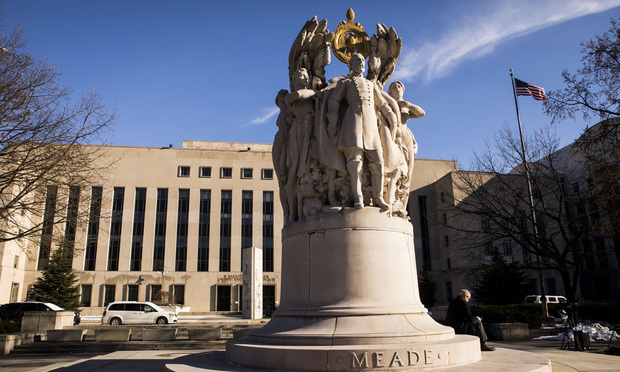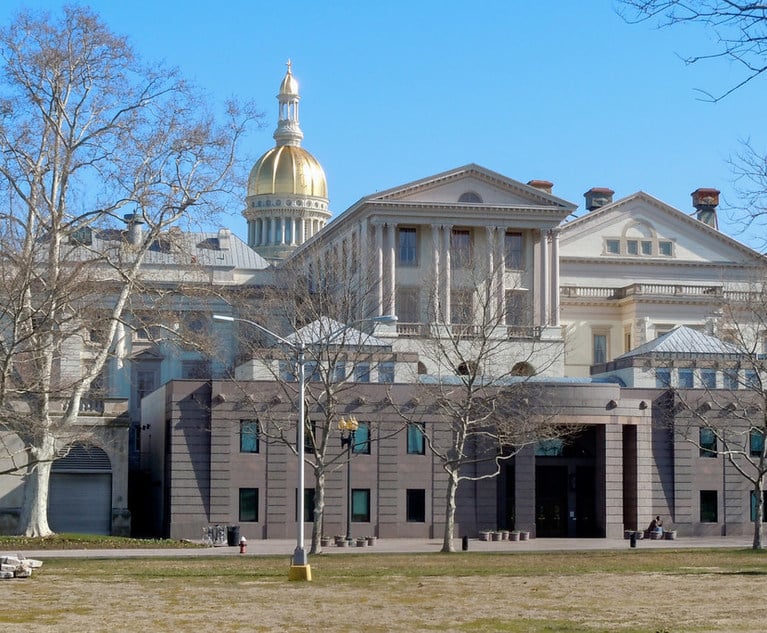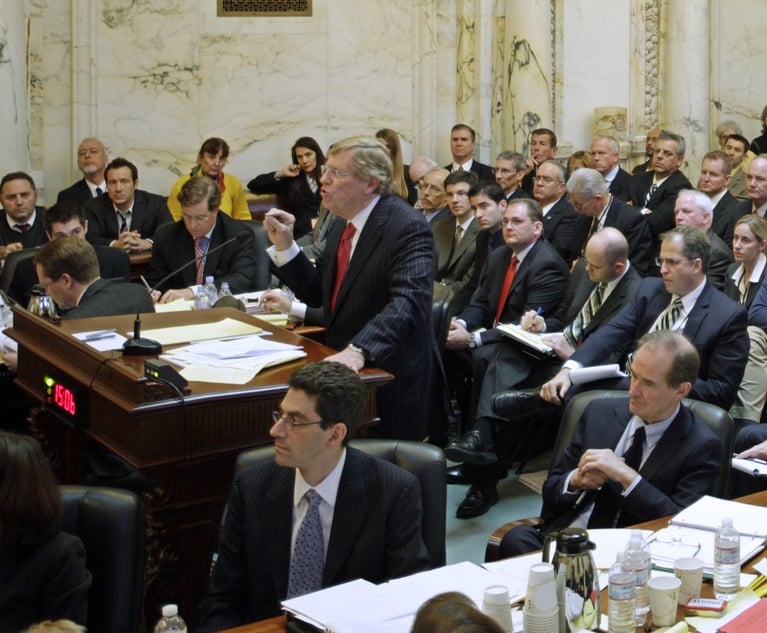When Crafting Your Litigation Strategy, Keep These Trends in Mind
Recent trends in how federal district courts exercise their power of judicial review underscore the changing nature of regulatory litigation.
September 24, 2019 at 04:01 PM
6 minute read
The original version of this story was published on National Law Journal
 E. Barrett Prettyman courthouse in Washington, D.C. March 22, 2018. Photo: Diego M. Radzinschi/ALM
E. Barrett Prettyman courthouse in Washington, D.C. March 22, 2018. Photo: Diego M. Radzinschi/ALM
Recent trends in how federal district courts exercise their power of judicial review underscore the changing nature of regulatory litigation. These trends start with the rise in multidistrict litigation, as groups of plaintiffs file complaints in multiple district courts to maximize their chances of blocking a federal policy. For their part, courts considering these challenges are exercising their power by refusing to defer to the executive branch and authorizing discovery. Individuals and businesses impacted by federal regulation should take these trends into consideration as they devise litigation strategies. (In the second installment of this two-part series, we will discuss two additional trends—the rigorous enforcement of the Administrative Procedure Act's standard of review and the rise of nationwide injunctions.)
Multidistrict litigation is booming.
The days when only a single judge would review a federal policy seem to be over with the explosion of multidistrict litigation.
Today, the government routinely faces multiple lawsuits across the country—from San Francisco to New York—as groups of plaintiffs file multiple challenges to federal policies. As but one example, district courts in California, New York, Washington, D.C., and Maryland each reviewed the Trump Administration's rescission of the Obama Administration policy known as Deferred Action for Childhood Arrivals.
For plaintiffs, multidistrict litigation provides multiple bites at the apple, increasing the likelihood that a court will enjoin the federal policy. By contrast, multidistrict litigation forces the government to run the table. And when a court enjoins a federal policy, the government must often seek extraordinary remedies—including from the U.S. Supreme Court—to defend the policy.
Expect this trend of multidistrict litigation to continue because the government often cannot channel multiple challenges into a single court.
Discovery is becoming the new norm.
Although discovery used to be rare in regulatory litigation, discovery is now increasingly common in challenges to government policies.
In regulatory litigation, courts typically review the agency's decision based exclusively on a record compiled by the agency. But the Supreme Court has allowed lower courts to look beyond the administrative record if there is a "strong showing of bad faith or improper behavior."
Until now, district courts rarely invoked this exception to allow plaintiffs to obtain discovery of the executive branch. But today, discovery orders (and related orders to supplement the administrative record) are increasingly common in high-profile cases. In the DACA cases, for example, the government sought mandamus from the Supreme Court to block extraordinary discovery orders.
The most recent example of discovery came in the census litigation involving the addition of a citizenship question. In Department of Commerce v. New York, the district court allowed extensive discovery and ordered the secretary of commerce to be deposed. Although the Supreme Court blocked the deposition, the Court upheld the district court's use of extra-record evidence.
Discovery often forces the government to take extraordinary steps to block discovery orders that risk disclosing privileged information. And those extraordinary efforts often force appellate courts to prejudge the merits of the case. Unless the Supreme Court provides definitive guidance, district courts seem inclined to continue ordering discovery in regulatory litigation, and the government will continue to seek extraordinary relief.
Deference is on the decline.
Courts are less likely to defer to the executive branch in two ways. First, courts have not been receptive to the government's argument that certain decisions are committed to the executive branch's discretion—and thus not reviewable by courts. And second, courts have resisted deferring to executive branch policies on the merits.
There is a long tradition that certain decisions are committed to the executive branch and thus beyond review by courts. This tradition is reflected in the Administrative Procedure Act, which says that matters "committed to agency discretion by law" are not reviewable. The Supreme Court has held that certain types of decisions—like the exercise of enforcement discretion—cannot be reviewed.
Yet courts have been more likely to apply a presumption in favor of judicial review in challenges to Trump Administration policies. In Trump v. Hawaii, for example, the Supreme Court refused to accept the government's argument that the Court had no role to play in reviewing the president's proclamation. And in the census case, the Supreme Court rejected the government's argument that it could not review the decision to add a citizenship question. The DACA cases, which the Court agreed to hear this term, will again test the government's argument that matters of enforcement discretion are committed to the executive branch.
Just as courts are resisting nonreviewability arguments, courts are also resisting requests to defer to the executive branch on the merits. Doctrines of judicial deference to the merits of executive branch policymaking—Chevron deference to interpretations of statutory ambiguities and Auer deference to interpretations of regulatory ambiguities—have long been debated and now seem to rest on shaky legal footing.
The Supreme Court entered this debate in Kisor v. Wilke. Although a divided court declined to overrule Auer deference, four justices would have done so. For his part, the Chief Justice wrote separately to emphasize Auer's limitations, and he signaled that the court's decision in Kisor had no bearing on issues surrounding Chevron deference.
Although the court has not considered the validity of that doctrine since City of Arlington v. FCC, the court has considered Chevron's underpinnings: Congress's delegation of lawmaking power to the executive branch through statutory silence and ambiguity.
Gundy v. United States was the Supreme Court's latest attempt to grapple with a broad delegation of lawmaking power to the executive branch. Although a plurality upheld the statute at issue, four justices (excluding Justice Kavanaugh, who did not participate) were willing to reconsider the nondelegation doctrine. Look for the Supreme Court to be called upon again soon to decide whether other laws are impermissible delegations of lawmaking power to the executive branch.
These recent trends have altered the course of regulatory litigation. Federal district courts are now exercising their power of judicial review by considering multiple challenges to executive branch policies, ordering discovery and avoiding deference. Each of these trends should be taken into account before engaging in regulatory litigation.
Donald F. McGahn II leads the government regulation practice at Jones Day. Before rejoining Jones Day in 2019, he served as counsel to the president of the United States. Brett A. Shumate is also a partner in the government regulation practice. Before joining Jones Day, he served in the U.S. Department of Justice as deputy assistant attorney general for the civil division's federal programs branch. This article represents the personal views and opinions of the authors and not necessarily those of the law firm with which they are associated.
This content has been archived. It is available through our partners, LexisNexis® and Bloomberg Law.
To view this content, please continue to their sites.
Not a Lexis Subscriber?
Subscribe Now
Not a Bloomberg Law Subscriber?
Subscribe Now
NOT FOR REPRINT
© 2025 ALM Global, LLC, All Rights Reserved. Request academic re-use from www.copyright.com. All other uses, submit a request to [email protected]. For more information visit Asset & Logo Licensing.
You Might Like
View All
Should It Be Left to the Plaintiffs Bar to Enforce Judicial Privacy Laws?
7 minute read
A Reporter and a Mayor: Behind the Scenes During the Eric Adams Indictment News Cycle

Of Predictive Analytics and Robots: A First-Year Federal Judge's Thoughts on AI
Trending Stories
- 1Avantia Publicly Announces Agentic AI Platform Ava
- 2Shifting Sands: May a Court Properly Order the Sale of the Marital Residence During a Divorce’s Pendency?
- 3Joint Custody Awards in New York – The Current Rule
- 4Paul Hastings, Recruiting From Davis Polk, Adds Capital Markets Attorney
- 5Chancery: Common Stock Worthless in 'Jacobson v. Akademos' and Transaction Was Entirely Fair
Who Got The Work
J. Brugh Lower of Gibbons has entered an appearance for industrial equipment supplier Devco Corporation in a pending trademark infringement lawsuit. The suit, accusing the defendant of selling knock-off Graco products, was filed Dec. 18 in New Jersey District Court by Rivkin Radler on behalf of Graco Inc. and Graco Minnesota. The case, assigned to U.S. District Judge Zahid N. Quraishi, is 3:24-cv-11294, Graco Inc. et al v. Devco Corporation.
Who Got The Work
Rebecca Maller-Stein and Kent A. Yalowitz of Arnold & Porter Kaye Scholer have entered their appearances for Hanaco Venture Capital and its executives, Lior Prosor and David Frankel, in a pending securities lawsuit. The action, filed on Dec. 24 in New York Southern District Court by Zell, Aron & Co. on behalf of Goldeneye Advisors, accuses the defendants of negligently and fraudulently managing the plaintiff's $1 million investment. The case, assigned to U.S. District Judge Vernon S. Broderick, is 1:24-cv-09918, Goldeneye Advisors, LLC v. Hanaco Venture Capital, Ltd. et al.
Who Got The Work
Attorneys from A&O Shearman has stepped in as defense counsel for Toronto-Dominion Bank and other defendants in a pending securities class action. The suit, filed Dec. 11 in New York Southern District Court by Bleichmar Fonti & Auld, accuses the defendants of concealing the bank's 'pervasive' deficiencies in regards to its compliance with the Bank Secrecy Act and the quality of its anti-money laundering controls. The case, assigned to U.S. District Judge Arun Subramanian, is 1:24-cv-09445, Gonzalez v. The Toronto-Dominion Bank et al.
Who Got The Work
Crown Castle International, a Pennsylvania company providing shared communications infrastructure, has turned to Luke D. Wolf of Gordon Rees Scully Mansukhani to fend off a pending breach-of-contract lawsuit. The court action, filed Nov. 25 in Michigan Eastern District Court by Hooper Hathaway PC on behalf of The Town Residences LLC, accuses Crown Castle of failing to transfer approximately $30,000 in utility payments from T-Mobile in breach of a roof-top lease and assignment agreement. The case, assigned to U.S. District Judge Susan K. Declercq, is 2:24-cv-13131, The Town Residences LLC v. T-Mobile US, Inc. et al.
Who Got The Work
Wilfred P. Coronato and Daniel M. Schwartz of McCarter & English have stepped in as defense counsel to Electrolux Home Products Inc. in a pending product liability lawsuit. The court action, filed Nov. 26 in New York Eastern District Court by Poulos Lopiccolo PC and Nagel Rice LLP on behalf of David Stern, alleges that the defendant's refrigerators’ drawers and shelving repeatedly break and fall apart within months after purchase. The case, assigned to U.S. District Judge Joan M. Azrack, is 2:24-cv-08204, Stern v. Electrolux Home Products, Inc.
Featured Firms
Law Offices of Gary Martin Hays & Associates, P.C.
(470) 294-1674
Law Offices of Mark E. Salomone
(857) 444-6468
Smith & Hassler
(713) 739-1250







